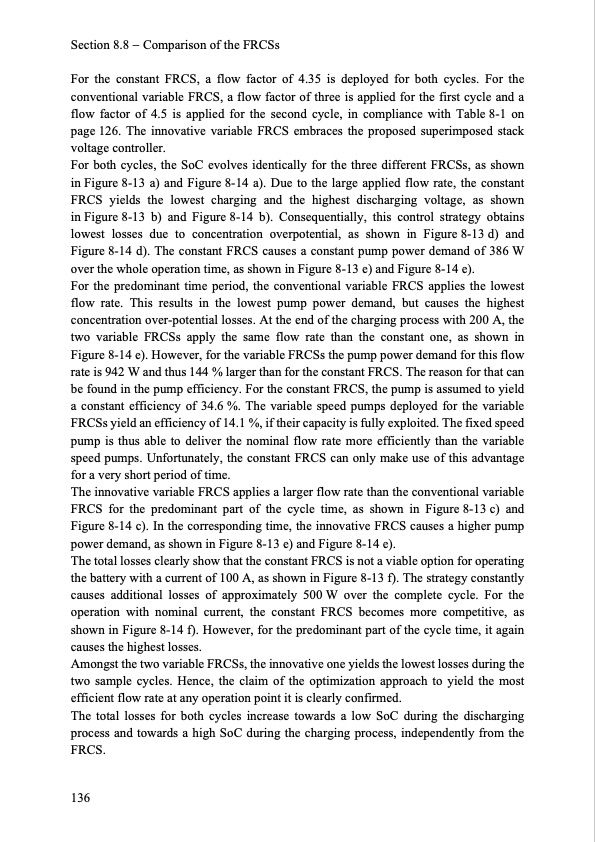
PDF Publication Title:
Text from PDF Page: 144
Section 8.8 Comparison of the FRCSs For the constant FRCS, a flow factor of 4.35 is deployed for both cycles. For the conventional variable FRCS, a flow factor of three is applied for the first cycle and a flow factor of 4.5 is applied for the second cycle, in compliance with Table 8-1 on page 126. The innovative variable FRCS embraces the proposed superimposed stack voltage controller. For both cycles, the SoC evolves identically for the three different FRCSs, as shown in Figure 8-13 a) and Figure 8-14 a). Due to the large applied flow rate, the constant FRCS yields the lowest charging and the highest discharging voltage, as shown in Figure 8-13 b) and Figure 8-14 b). Consequentially, this control strategy obtains lowest losses due to concentration overpotential, as shown in Figure 8-13 d) and Figure 8-14 d). The constant FRCS causes a constant pump power demand of 386 W over the whole operation time, as shown in Figure 8-13 e) and Figure 8-14 e). For the predominant time period, the conventional variable FRCS applies the lowest flow rate. This results in the lowest pump power demand, but causes the highest concentration over-potential losses. At the end of the charging process with 200 A, the two variable FRCSs apply the same flow rate than the constant one, as shown in Figure 8-14 e). However, for the variable FRCSs the pump power demand for this flow rate is 942 W and thus 144 % larger than for the constant FRCS. The reason for that can be found in the pump efficiency. For the constant FRCS, the pump is assumed to yield a constant efficiency of 34.6 %. The variable speed pumps deployed for the variable FRCSs yield an efficiency of 14.1 %, if their capacity is fully exploited. The fixed speed pump is thus able to deliver the nominal flow rate more efficiently than the variable speed pumps. Unfortunately, the constant FRCS can only make use of this advantage for a very short period of time. The innovative variable FRCS applies a larger flow rate than the conventional variable FRCS for the predominant part of the cycle time, as shown in Figure 8-13 c) and Figure 8-14 c). In the corresponding time, the innovative FRCS causes a higher pump power demand, as shown in Figure 8-13 e) and Figure 8-14 e). The total losses clearly show that the constant FRCS is not a viable option for operating the battery with a current of 100 A, as shown in Figure 8-13 f). The strategy constantly causes additional losses of approximately 500 W over the complete cycle. For the operation with nominal current, the constant FRCS becomes more competitive, as shown in Figure 8-14 f). However, for the predominant part of the cycle time, it again causes the highest losses. Amongst the two variable FRCSs, the innovative one yields the lowest losses during the two sample cycles. Hence, the claim of the optimization approach to yield the most efficient flow rate at any operation point it is clearly confirmed. The total losses for both cycles increase towards a low SoC during the discharging process and towards a high SoC during the charging process, independently from the FRCS. 136PDF Image | Model-based Design Vanadium Redox Flow Batteries

PDF Search Title:
Model-based Design Vanadium Redox Flow BatteriesOriginal File Name Searched:
10-5445IR1000070670.pdfDIY PDF Search: Google It | Yahoo | Bing
Salgenx Redox Flow Battery Technology: Salt water flow battery technology with low cost and great energy density that can be used for power storage and thermal storage. Let us de-risk your production using our license. Our aqueous flow battery is less cost than Tesla Megapack and available faster. Redox flow battery. No membrane needed like with Vanadium, or Bromine. Salgenx flow battery
| CONTACT TEL: 608-238-6001 Email: greg@salgenx.com | RSS | AMP |